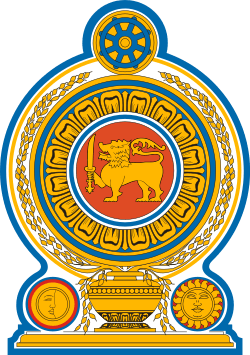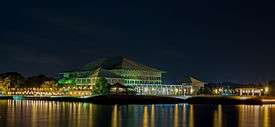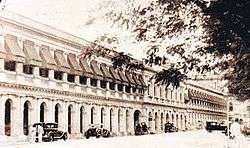Parliament of Sri Lanka
| Parliament of Sri Lanka ශ්රී ලංකා පාර්ලිමේන්තුව இலங்கை பாராளுமன்றம் | |
|---|---|
| 15th Sri Lankan Parliament | |
 | |
| Type | |
| Type | |
| Leadership | |
|
Dhammika Dasanayake Since 18 August 2015 | |
| Structure | |
| Seats | 225 |
 | |
Political groups |
Government (156) Opposition (69) |
Length of term | 5 years |
| Elections | |
| Proportional representation | |
Last election | 17 August 2015 |
Next election | On or before 17 August 2020 |
| Meeting place | |
 | |
| Parliament Building, Sri Jayawardenepura Kotte | |
| Website | |
|
www | |
The Parliament of Sri Lanka (Sinhala: ශ්රී ලංකා පාර්ලිමේන්තුව Sri Lanka Parlimenthuwa) is the 225-member unicameral legislature of Sri Lanka. The members of Parliament are elected by proportional representation for five-year terms, with universal suffrage. Parliament reserves the power to make all laws. It is modeled after the British Parliament.
The Speaker or, in his absence the Deputy Speaker and Chairman of Committees or the Deputy Chairman of Committees, presides over Parliament.
The nation's President has the power to summon, suspend, prorogue, or terminate a legislative session and to dissolve the Parliament.
Of the 225 members, 196 are elected from 22 electoral districts, which are multi-member. The remaining 29 MPs are elected from National Lists allocated to the parties (and independent groups) in proportion to their share of the national vote.
History

The first legislature established in Ceylon was the Executive Council and the Legislative Council, which were established on March 13, 1833 according to the recommendations of the Colebrook-Cameron commission. The Executive Council was composed of the Colonial Secretary, the officer commanding the Military Forces, the Attorney General, the Auditor-General and the Treasurer and the duties of the council were advisory and the Governor of Ceylon, who presided over their meetings and consulted them but was at liberty to disregard their advice. At first it was made up of only British officials but later included native citizens. At the beginning 16, and later 49, members were elected for the Legislative Council, but a limited number of people were qualified to vote.
In 1931 the Legislative Council was dissolved and in its place a more powerful State Council of Ceylon was established with its 101 members elected by universal adult franchise as provided by the Donoughmore Constitution.
Prior to the granting of independence and the establishment of the Dominion of Ceylon on 4 February 1948, a new bicameral parliament was established in 1947, according to the recommendations of the Soulbury Commission after the State Council was dissolved. It was based on the Westminster model with an upper house, the Senate, whose members were appointed and a lower house of parliament, the House of Representatives, whose members were elected. The House of Representatives consisted of 101 Members (increased to 157 in 1960) and the Senate consisted of 30 Members, of whom 15 were elected by the House of Representatives and 15 nominated by the Governor-General of Ceylon.
The Senate was abolished on 2 October 1971. On 22 March 1972 when the republic constitution was enacted, the House of Representatives was replaced with the National State Assembly which had 168 elected members. This itself was replaced by the Parliament of Sri Lanka when the constitution of the Democratic Socialist Republic of Sri Lanka was enacted in 1977.
In 1987, a grenade was lobbed into a conference room inside the Parliament complex where government MPs were meeting. Two people were killed and sixteen injured, but the target of the attack, President J. R. Jayawardene escaped unhurt. The Janatha Vimukthi Peramuna claimed responsibility for the attack.
On 20 August 2015, Two major parties the United National Party and Sri Lanka Freedom Party have signed Memorandum of Understanding to form the National Government in order to address major unresolved issue after the end of 30-year old ethnic conflict, This is the first time in Sri Lanka's political history that two major parties agrees to work in the joint government.[1] The Presidential Secretariat announced that the Government will be functioning as joint (national unity) government comprising two major parties.[2][3]
Parliament Secretariat
The Parliament Secretariat, headed by the Secretary General of Parliament, is in charge of all its administrative duties. Until 1972, the post was known as Clerk of Parliament. Currently the Secretary General's administration is divided into eight departments.
These departments are;
- Department of Serjeant-at-Arms
- Department of Administration
- Department of Legislative Services
- Department of Hansard
- Department of Finance & Supplies
- Department of Information Systems and Management
- Co-ordinating Engineer's Department
- Department of Catering & Housekeeping
The Sergeant-at-Arms is responsible for security and acts also as master-of-ceremonies.
The Staff Advisory Committee (SAC) established under the Parliamentary Staff Act provides advice and guidance to the Parliamentary Secretariat with respect to matters concerning Parliamentary staff. The SAC consists of the Speaker (Chairman), the Leader of the House, the Minister of Finance and the Leader of the Opposition.
Parliament buildings

Under the British Colonial government, when the Executive Council and the Legislative Councils were set up in 1833, they met in a building opposite Gordon Gardens, which is now the "Republic Building", occupied by the Ministry of Foreign Affairs. On January 29, 1930 the British Governor of Ceylon, Sir Herbert Stanley (1927–1931), opened a building fronting the ocean at Galle Face, Colombo, designed for meetings of the Legislative Council. It was subsequently used by the State Council (1931–1947), the House of Representatives (1947–1972), the National State Assembly (1972–1977) and the Parliament of Sri Lanka (1977–1981). Today the Old Parliament Building is used by the Presidential Secretariat.
In 1967 under Speaker Albert F. Peris, the leaders of the political parties unanimously resolved that a new Parliament building be constructed on the opposite side of Beira Lake from the existing Parliament at Galle Face, but no further action was taken. While Stanley Tillekeratne was the Speaker (1970–77), the leaders of the political parties entrusted the drawing up of plans for a new Parliament building to architects, but the project was subsequently abandoned.
On July 4, 1979, Prime Minister Ranasinghe Premadasa obtained sanction from Parliament to construct a new Parliament Building at Duwa, a 5 hectare (12 acre) island in the Diyawanna Oya (off Baddegana Road, Pita Sri Jayawardenapura-Kotte) about 16 kilometres (9.9 mi) east of Colombo. The island was where the palace of the King Vikramabahu III's powerful Minister Nissaka Alakesvara had been situated. It had belonged to E. W. Perera prior to being vested in the state.
The building was designed by architect Deshamanya Geoffrey Bawa and built with Sri Lankan funds. On April 29, 1982, the new Parliamentary Complex was declared open by President J.R. Jayewardene.
Current layout

See also
References
- ↑ "Ranil takes oath as PM: MoU signed for national govt.". Sri Lanka Mirror. 21 August 2015. Retrieved 23 August 2015.
- ↑ "Sri Lanka main opposition party agrees to form national government with ruling UNP". ColomboPage. 20 August 2015. Retrieved 23 August 2015.
- ↑ "Sri Lankan president warns Mahinda Rajapaksa loyalists against toppling government". The Economic Times. 9 September 2015. Retrieved Sep 11, 2015.
External links
Coordinates: 6°53′12″N 79°55′07″E / 6.8868°N 79.9187°E